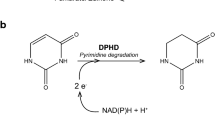Abstract
In filamentous fungi, lysine is synthesized via the α-aminoadipate pathway. In order to gain insight into this fungus-specific pathway (to date, no genes for enzymes of this pathway in filamentous fungi have been cloned) the lysine auxotrophic mutant LysF88 of Aspergillus nidulans was studied. HPLC and 1H-NMR analyses revealed that LysF88 accumulated homocitric acid in the culture supernatant. In addition, both the LysF88 mutant strain and LysF deletion strain (LysFKO) described here showed hardly any homoaconitase activity, indicating that lysF encodes homoaconitase. The lysF gene was cloned by complementation of the LysF88 mutant and sequenced. It has a size of 2397 bp, including a single intron of 72 bp. The two exons encode an open reading frame (ORF) of 2325 bp. The calculated Mr of the homoaconitase protein (775 amino acids) is 83 943. A major and a minor transcript begin at positions −28 and −32, respectively. The 3′ end of the lysF cDNA showed a poly(A) tail commencing at position +2647 following a 250 bp untranslated region after the lysF stop codon. A putative polyadenylation signal sequence (TATAAA) is located 49 bp upstream of the polyadenylation site. Computer analysis revealed 55% amino acid sequence identity between the products of the putative homoaconitase ORF of A. nidulans and that of the recently sequenced homologous Saccharomyces cerevisiae. The similarity was particularly obvious in a region of cysteine residues, which are characteristic of an iron-sulfur cluster, implying that homoaconitase contains such a cluster. The homoaconitases of A. nidulans and S. cerevisiae share only 20% sequence identity with S. cerevisiae aconitase. The pH optimum for the activity of A. nidulans homoaconitase in 0.1 M potassium phosphate buffer is between pH 8.1 and pH 8.6. Homoaconitase exhibited an apparent Km of 1.1 mM toward homoisocitric acid. The specific activity of homoaconitase was reduced by up to six-fold in mycelia grown in the presence of l-lysine, suggesting that it is regulated by lysine.
Similar content being viewed by others
Author information
Authors and Affiliations
Additional information
Received: 4 July 1996 / Accepted: 20 January 1997
Rights and permissions
About this article
Cite this article
Weidner, G., Steffan, B. & Brakhage, A. The Aspergillus nidulans lysF gene encodes homoaconitase, an enzyme involved in the fungus-specific lysine biosynthesis pathway. Mol Gen Genet 255, 237–247 (1997). https://doi.org/10.1007/s004380050494
Issue Date:
DOI: https://doi.org/10.1007/s004380050494



